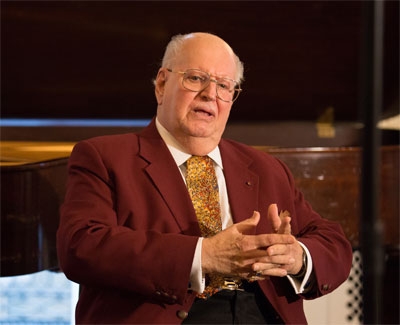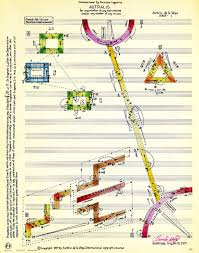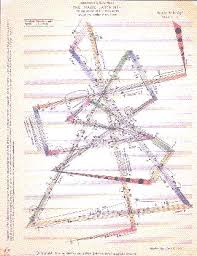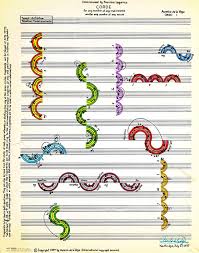Literatura. Crítica.
Por Manuel Gayol Mecías.
Traducción al inglés: Aurelio de la Vega…
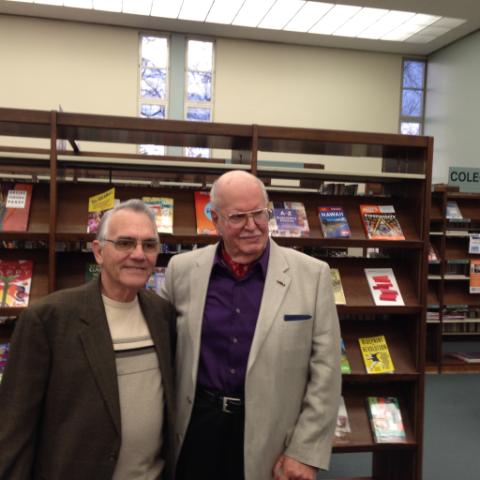
Aurelio de la Vega (right) y Manuel Gayol Mecías, en el Club del Pensamiento Crítico, en la Huntington Park Public Library
Aurelio De La Vega: Rebel with a Cause is an excellent documentary of Camilo Vila that shows a historical man still making history. De La Vega’s music merges all the human emotions and exalts the virtue of feeling—the only intuitive way to fuse the intelligence with the sensitivity of the spirit. His music is a forge of emotions, sometimes flowing in a racket of hands and claps, at other times breeding sounds of far away grandiosity. It is a music expressed in most intimate and remote harmonies like ancestral dreams that breath in cities and plazas discovering secluded horizons of marine twilight. This is Aurelio’s verb, proclaiming a war of nerves, a peace of arpeggios slowly quieting to suddenly find silence’s perfect combination. That silence, though, secretly speaks, as to prepare us for thesplendid eruption of an anxious chimera that just begins. From my point of view, one of the most important characteristics of Aurelio’s compositions is the complex addition of human feelings it exhibits, making it a kaleidoscopic compendium of trepidations that produce an exalted quivering in the auditor, awakening sensations only fully perceived by the intelligence of the heart; in a word, the rage and the quiescence of the sounds which make themselves magically alive.
As we affirmed before, Aurelio De La Vega is, in fact, a historical composer of classical music still provoking history. He is awe-inspiringly portrayed, soul and body, in this exceptional documentary by Camilo Vila, which shows De La Vega’s authentic sequence of love with life, with his own work and with a profound Cuba, thus portraying a man who has richly respired within the cosmos of sound. His music is a reliable reflection of how human feelings and thoughts are perceived and projected through a cultured intelligence, as well as an example of an essential emotivism which lies hidden in a Cuba still unknown, buried in that invisible and suffered island, awaiting for a true discovery. Aurelio De La Vega is the occult side of a class of Cuban very unperceived in his own homeland, but who has always existed and exists, vibrating in history’s remoteness and in the horizon of a country that some day, through a free, universal, non-political education, will raise from its ashes to be what it truly deserves to be: a luminous land free of hate and envy. One must point out that the anti-communist spirit of De La Vega made him reside in the United States, far away from any contact with the Castro regime. He has paid dearly from this valiant attitude, his music censored and proscribed in Cuba, making it virtually unknown to several Cuban generations. This Stalinist, non-existing status, was inexorably maintained until 2012, when awareness of his music, if not playing it, surfaced. This was followed by courageous broadcasting of some of his works and recently and finally, the physical playing of two of his compositions after 56 years of a forced parentheses.
With the same intensity that Aurelio abhorred Communism, he never had communion with the vulgar idea that Cuban music was, and is, no more than rhythm and drums, winsomeness and revelry for dancing, magnificently good for moving the buttocks and hips –an outdated image dating from the Republic which proclaims that Cuba is only an island where one goes to carouse, to enjoy the simple, sexual and primitive pleasures of life, without any type of intelligent use of taste or cultural explorations. Together with this false and stereotyped affirmation, the fact remains that, for many years, there has been very little promotion of the classical Cuban music that has existed in the island, starting in the XIX and XX centuries and arriving at the XXI. Figures like Ignacio Cervantes, Laureano Fuentes, Hubert de Blanck, José White, Ignacio Espadero y José Manuel “Lico” Jiménez, among others in past centuries, and Amadeo Roldán, Alejandro García Caturla, Gonzalo Roig, Carlos Fariñas, Julián Orbón and Aurelio De La Vega in recent times, have nobly placed the name of Cuba in the international music scene. But due to the intensity and easiness with which the world at large has accepted Cuban popular music, the exceptional quality of Cuban classical music has been mostly ignored. Regarding these facts, Aurelio has always remained as a highly sensitive and elegant human being, creating his music far away from vulgarism, opportunism and easy populism, gearing his creativity towards that model which inserts itself in the labyrinths of Spanish philosopher María Zambrano’s The Secret Cuba. She herself, in a sudden impulse of solidarity and filiation with intelligent, cultured Cubans, once explained to José Lezama Lima her discovery of the conundrum that was Cuba. That mystery creates a parallelism with De La Vega’s music, whose composer’s steps have been able to revolutionize Cuba’s art music not only in its local catalogue but in the big diapason of international classical music. However, Aurelio’s exemplary creativity remains concealed to the great majority of Cubans, partially hidden in the shadows and the mist of political censorship.
Independently that in Cuba, after the decade of the 1960s, there exists a certain cultivation of an art music that goes beyond the popular genres (one must remember Leo Brouwer’s initiative to try to find new sounds through the creations of the ICAIC Group of Experimental Sound), the political populist obsession that still flourishes in the island, implanted, defended and unfurled by the “revolutionary” government, has brought forth the fact that classical music is still highly overshadowed by rumbas, sones, chachachá, mambos and guaguancós and by the internationally labeled salsa music, which is simply Cuban dance music. To such an extreme this phenomenon remains ever present that one must remember that music in the island was represented in Republican Cuba by the fiery mulatas of Tropicana, and in today’s socio political climate by the Buena Vista Social Club. This type of circumstance has molded Aurelio De La Vega’s strong disbelief in the populist image, full of vulgarity, which underlines the common portrait of Cuban music—an image that has greatly hurt the profile of the island’s culture and has become an insult for many of us, human beings who think and feel. And now that I mention thought and felling as a point of civilized equilibrium, I come back to the superb documentary of Camilo Vila, where Aurelio so well expresses his preference for the cultivated form of creating an intelligent music, which transforms his compositions into projections of emotions beautifully expressed by a thinking creature. Vila’s professional and effectively directional creation captures the voices of different distinguished composers, interpreters, musicologists, painters and writers who talk and comment on the repercussion and importance of Aurelio De La Vega’s music, as a way to pay homage to the strength and unusual validity of this remarkable Cuban composer.
_____________________________________
Manuel Gayol Mecías is the Director and Editor of Palabra Abierta (“Open Word”; www.plabrabierta.com), and a Cuban writer and newspaper man. He holds a 1979 Master’s Degree in Hispanoamerican Language and Literature from the University of Havana. He was a Senior Researcher in the Literature Investigation Center of the Casa de las Américas (Havana, 1979-1989), and was a member of the editorial board of Vivarium magazine, a review published under the tutelage of the Archidiosis of Havana. He has published innumerable critic essays, short stories, novels and poetry in many Cuban and foreign literary reviews and newspapers, and has been the recipient of various prizes in literature, among them the Short Story National Prize of the Union of Writers and Artists of Cuba (UNEAC), 1992, and the Enrique Labrador Ruiz International Short Story Prize of the Círculo de Cultura Panamericano (Pan-American Circle of Culture) of New York, 2004. He worked as editor of Contact Review, from 1994 to 1996. He worked at La Opinión Spanish Newspaper as Editor and Copyeditor (1998 to 2014). At present, he is one of the founders of the Club del Pensamiento Crítico at the Huntington Park Public Library. Published works include Retable of the Fable (Poems, Editorial Letras Cubanas, 1989); Multiple Appraisal of Andre’s Bello (Compilation, Editorial Casa de las Américas, 1989); The Jaguar is an Amber Dream (Short stories, Provincial Center of the Havana Book Editorial, 1990); Return of the Doubt (Poems, Vivarium Editions, Archiepiscopal Center of Studies, Havana, 1995); The Night of the Great Goth (Short stories, Neo Club Editions, Miami, 2011); Eyes of Red Goth (Short stories, Neo Club Editions, Miami, 2012); Marja and the Eye of the Maker (Novel, Neo Club Editions, Miami, 2013); Inverse Trip towards the Reign of the Imagery (Essays, Neo Club Editions, Miami, 2014) and The Fire’s Artifice (Short stories, Neo Club Editions, Miami, 2014).
[Texto original en inglés traducido por el Dr. Aurelio de la Vega. A continuación el original en español]
Emoción, inteligencia, rebeldía y causa en Aurelio de la Vega,
en el documental de Camilo Vila
Por Manuel Gayol Mecías…
Aurelio de la Vega: A Rebel with a Cause es un excelente documental de Camilo Vila, que muestra a un hombre histórico aún haciendo historia. Su música aúna todas las emociones humanas, enaltece la virtud del sentir, única manera intuitiva de fundir la inteligencia con la sensibilidad del corazón. Su música es fragua de emociones; fluye a veces en estrépitos de manos y palmadas y en sonidos de grandiosidades lejanas. Recurre a una armonía muy íntima, remota, como de sueños ancestrales que terminan respirando en ciudades y plazas, en lejanos horizontes de crepúsculos marinos. Así es Aurelio por dentro, como una guerra de nervios, como una paz de arpegios que se van sosegando y encuentran de pronto la combinación perfecta de un silencio. Pero ese silencio habla preparándonos para el estallido magnífico de una ansiosa quimera que comienza. Una de las características importantes de sus composiciones, a mi modo de ver, es la suma compleja de emotividades humanas; es el hecho de ser una música de emociones para emocionar, para sentir, y de convertirse en sensaciones solo percibidas por la inteligencia del corazón. La furia y la paz de los sonidos que se hacen sentir.
En efecto, Aurelio de la Vega es un histórico compositor de música clásica aún haciendo historia. Y es retratado en cuerpo y alma en este excelente documental de Camilo Vila que muestra una auténtica secuencia de amor con la obra, con la vida y con una Cuba profunda por parte de un hombre que ha respirado todas las emociones que pueden dar los sonidos. Su música es un reflejo fehaciente de las sensaciones y sentimientos humanos que son ordenados y proyectados mediante una inteligencia culta; y es un ejemplo de esa emotividad esencial que yace todavía escondida en la Cuba que no se conoce, una isla invisible que todavía está por descubrirse. Aurelio de la Vega es la parte oculta de una clase de cubano que nunca en la misma isla se le ha dado a conocer con fuerza pero que siempre ha existido y existe, y que vibra en lo remoto de la historia y en el horizonte de un país que algún día —con educación, con una verdadera y universal educación— se alzará de sus cenizas para entonces ser lo que está llamado a ser…
Por otra parte, el espíritu anticomunista de Aurelio de la Vega lo llevó siempre a mantenerse en Estados Unidos, fuera de cualquier tipo de roce con el régimen castrista. De ahí que su música estuviera censurada y no se conociera en Cuba, quizás únicamente de alguna manera clandestina, hasta el año 2012 en que se volvió a hacer mención de sus obras, y estas pudieron ser escuchadas por primera vez por nuevos compositores y músicos amantes de lo clásico.
Aurelio siempre fue opuesto rotundamente a cualquier tipo de ideas comunistas, y en especial, a las de los hermanos Castro. Pero al mismo tiempo no comulgó jamás con esa idea chabacana de que la música cubana era/es ritmo y charanga, sandunga y bochinche para bailar, que solo sirve para ver mover las nalgas y la cintura de una mujer, imagen trasnochada que viene desde la República, de que Cuba resultaba y resulta ser únicamente una isla para ir a rumbear, y gozar de los placeres simplones de la vida, sin ningún tipo de uso inteligente del gusto, cuando eso siempre ha sido una gran falsedad; pero que junto a ello (a la falsedad del estereotipo, digo) desde hace muchos años se ha dejado de promover, o no se ha promovido con la intensidad que se requiere, la música erudita y seria que sí ha existido en Cuba, incluso desde el siglo XIX hasta el XX. Figuras como Ignacio Cervantes, Laureano Fuentes, Hubert de Blanck, José White y José Manuel “Lico” Jiménez, entre otros, en el siglo antes pasado; y Amadeo Roldán, Alejandro García Caturla, Gonzalo Roig, Ernesto Lecuona y Aurelio de la Vega, por solo citar algunos nombres más ya en el siglo XX, han sabido poner (y lo han hecho con creces) el nombre de Cuba muy en alto en el panorama de la música clásica internacional. Pero debido al facilismo con que se ha sentido y acogido siempre la música popular, esta veta de calidad extraordinaria de la música clásica cubana, podríamos decir, no ha llegado a convertirse y servir como el otro modelo, el de la Cuba culta que siempre ha parecido inexistente.
En esto Aurelio siempre se ha ubicado como un ser altamente sensible, que ha sabido dedicarse con todo el corazón a ese modelo que se inserta en los laberintos de La Cuba secreta, de la filósofa española María Zambrano, quien se lo expresara alguna vez al propio José Lezama Lima en un arranque de solidaridad y filiación entre seres privilegiados y originistas, y hechizada por las cosas valederas y esenciales de la isla; y que se hace unísono aquí con el ejemplo de De la Vega, en cómo sus pasos de compositor han podido (y lo han logrado) revolucionar la música culta cubana no solo dentro de su catálogo local, sino además dentro del gran diapasón de la música clásica internacional. Ejemplaridad de Aurelio quien para la mayoría de los nativos en Cuba ha quedado oculto, o para unos pocos ha permanecido en las sombras y las brumas de la censura.
Independientemente de que después de los años 60 se haya empezado a trabajar más este tipo de música académica, incluso por encima de la música popular (hay que recordar la iniciativa de Leo Brouwer, director de la Orquesta Sinfónica de La Habana en aquel entonces, de buscar un nuevo sonido mediante la creación del Grupo de Experimentación Sonora del ICAIC), esfuerzo que fue más allá de lo popular, ha sido por al afán político del populismo implantado, defendido y desarrollado por el mismo gobierno “revolucionario”, que lo clásico en realidad siempre quedó (y ha quedado) por detrás de lo popular (la rumba, el son, el chachachá, el mambo y el guaguancó, entre otros, y la llamada internacionalmente música salsa, que no es otra cosa sino música cubana bailable) a un extremo tal que en cuanto a ritmo y música a la isla no se le conoce más que por las mulatas chancleteras de Tropicana, en aquellos tiempos, y hoy en día por la revelación del grupo Buena Vista Social Club.
Es este tipo de circunstancia la que ha llevado a Aurelio de la Vega a no creer ni contribuir con la promoción de esta única imagen populista, y más incluso, podríamos decir populachera que tanto daño nos ha hecho como seres que también pensamos y sentimos. Y ahora que hablo de pensar y de sentir como un conjunto de equilibrio humano, vuelvo a tocar el documental de Camilo Vila en el que Aurelio deja bien expreso —sin desdorar la música popular, claro está— su preferencia por el modo culto de hacer música inteligente, composiciones las suyas que al mismo tiempo sirven para proyectar las emociones y las circunstancias de cualquier ser sensible. Por su parte, la profesional y certera dirección de Vila, deja que las voces de diferentes y destacados compositores, intérpretes, investigadores y escritores hablen de la repercusión e importancia de la música de Aurelio de la Vega, como una manera más de testimoniar la fuerza y la validez peculiar de este laureado autor cubano.
©Aurelio de la Vega. All Raights Reserved
©Manuel Gayol Mecías. All Rights Reserved

